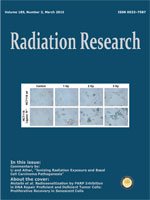Weightlessness during spaceflight leads to functional changes in resistance arteries and loss of cancellous bone, which may be potentiated by radiation exposure. The purpose of this study was to assess the effects of hindlimb unloading (HU) and total-body irradiation (TBI) on the vasomotor responses of skeletal muscle arteries. Male C57BL/6 mice were assigned to control, HU (13–16 days), TBI (1 Gy 56Fe, 600 MeV, 10 cGy/min) and HU-TBI groups. Gastrocnemius muscle feed arteries were isolated for in vitro study. Endothelium-dependent (acetylcholine) and -independent (Dea-NONOate) vasodilator and vasoconstrictor (KCl, phenylephrine and myogenic) responses were evaluated. Arterial endothelial nitric oxide synthase (eNOS), superoxide dismutase-1 (SOD-1) and xanthine oxidase (XO) protein content and tibial cancellous bone microarchitecture were quantified. Endothelium-dependent and -independent vasodilator responses were impaired in all groups relative to control, and acetylcholine-induced vasodilation was lower in the HU-TBI group relative to that in the HU and TBI groups. Reductions in endothelium-dependent vasodilation correlated with a lower cancellous bone volume fraction. Nitric oxide synthase inhibition abolished all group differences in endothelium-dependent vasodilation. HU and HU-TBI resulted in decreases in eNOS protein levels, while TBI and HU-TBI produced lower SOD-1 and higher XO protein content. Vasoconstrictor responses were not altered. Reductions in NO bioavailability (eNOS), lower anti-oxidant capacity (SOD-1) and higher pro-oxidant capacity (XO) may contribute to the deficits in NOS signaling in skeletal muscle resistance arteries. These findings suggest that the combination of insults experienced in spaceflight leads to impairment of vasodilator function in resistance arteries that is mediated through deficits in NOS signaling.
How to translate text using browser tools
1 March 2016
Effects of High-LET Radiation Exposure and Hindlimb Unloading on Skeletal Muscle Resistance Artery Vasomotor Properties and Cancellous Bone Microarchitecture in Mice
Payal Ghosh,
Brad J. Behnke,
John N. Stabley,
Cody R. Kilar,
Yoonjung Park,
Anand Narayanan,
Joshua S. Alwood,
Yasaman Shirazi-Fard,
Ann-Sofie Schreurs,
Ruth K. Globus,
Michael D. Delp
ACCESS THE FULL ARTICLE

Radiation Research
Vol. 185 • No. 3
March 2016
Vol. 185 • No. 3
March 2016




